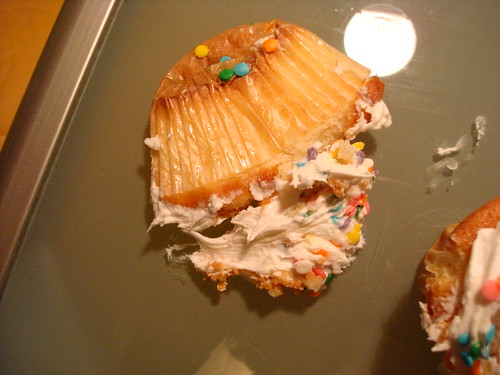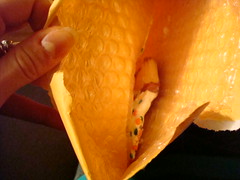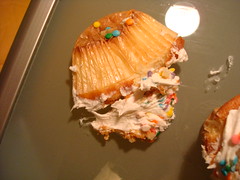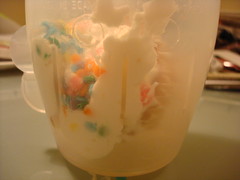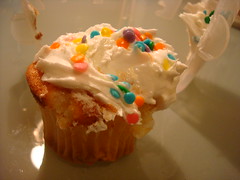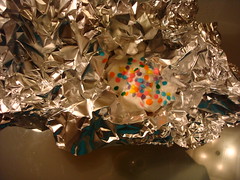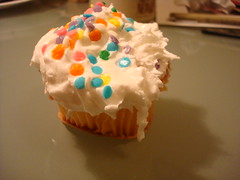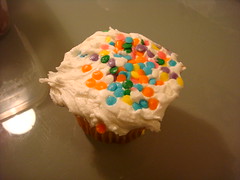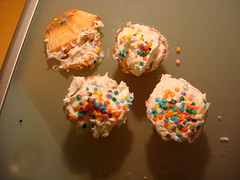What is the best way to ship a cupcake? How should you definitely not ship a cupcake? In an effort to find the truth, Cakespy recently did a cupcake experiment, shipping four parcels of cupcakes in four different ways to see which would fare best. For a quick review, this is how each of them was packed:
Box 1: A cupcake in a padded envelope just by itself, no additional packing material.
Box 2: An individual cupcake packed in the Cup-a-cake carrier with bubble wrap in a box.
Box 3: A cupcake wrapped in tinfoil and surrounded by newsprint, then packed in a box.
Box 4: Four cupcakes (packed this way so they would not slide around) packed in an airtight container, then padded it with newsprint and packed in a box.
So we shipped them off, and then we waited. Sure, we had our guesses as to the outcome, and so did you: most readers thought either the Cup-a-Cake or airtight container packages would fare best. But would there be any surprises? Only time would tell. And gratification was ours on Wednesday night, when we found the packages (above) waiting for us at our front door. Upon eagerly opening them, here’s what we found:
Box 1, Packed in Padded Mailer (above): Before opening, we noted that the envelope was suspiciously flat, and bore a tiny grease stain on the top. This did not bode well. Upon opening it, our suspicions proved correct: the cake was crushed. However, we were amazed by how contained it had remained; the frosting was not all over the inside, but had still retained the shape (albeit flat) of a mound of cupcake frosting. It made us think of what might happen if you tried to fry a cupcake grilled-cheese style. We probably wouldn’t eat it, but have to admit this was the most fascinating one to look at.
Box 2, packed in the Cup-a-Cake carrier (above): When we found the packages at our door, we found this one resting on its side. We weren’t too worried; it had felt so secure when we'd packed it. However, upon opening...cupcake carnage! The poor cake had turned sideways in its carrier, and frosting was all over the inside. Nonetheless, once taken out of its plastic prison, although not pretty, we'd still rate it eatable.
Box 3, Packed in tinfoil (above): Actually, we were surprised by how well this one held up, considering the pliable nature of tinfoil. When we unpacked it, the bottom of the cup was a little bit scrunched on one side, and the frosting had taken on a look as if it had been decorated by an overzealous kindergartner. All in all though, it had held its shape rather impressively, and was definitely still eatable, if slightly compromised in looks.
Box 4, Four packed together in an airtight container (above): These cakes fared surprisingly well, with only a minimal amount of frosting smeared on the sides of the case. It did not appear that any had capsized or shifted too much; being packed together, they had held each other in position, and when taken out of the box, didn’t look so bad at all; we can attest that they were still edible and yummy, in that guilty way that only grocery-store bought cakes can be.
*Cakespy Note: Although the photos cannot reflect this, we would be remiss if we did not mention the amazing smell that greeted us upon opening each box. It was sugary, sweet, and not too strong as to be obtrusive: sweet cake aromatherapy.
So, with all said and done, what did we learn from this experiment? To sum it up:
-Cupcakes that have been shipped might not be cute, but do still taste good if shipped and received in a timely manner.
-Shipping Cupcakes in padded mailers, while not necessarily a “good” idea, is strangely fascinating and kind of fun.
-Perhaps there is safety in numbers when shipping cupcakes: judging by the success of the four cupcakes in an airtight container, we think that perhaps the cakes balanced out the weight in addition to anchoring one another in position.
-Whereas we once thought that companies who ship cupcakes charged too much for shipping, we now have a better understanding of why it costs so dearly to deliver cupcakes that look and taste good.

